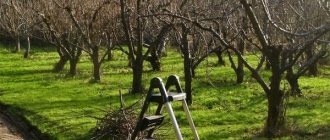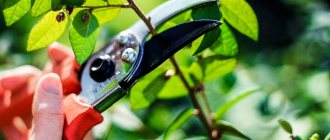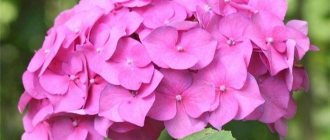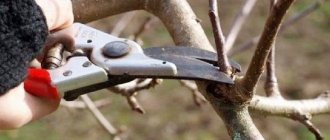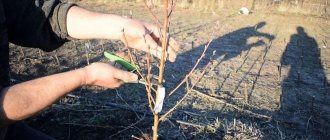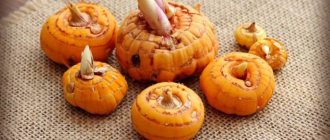Almost every gardener has apple trees in his garden.
There are a huge number of varieties of this garden crop; apple trees grow almost everywhere, on any soil and bear fruit well.
But to achieve high productivity, apple trees need to be given a lot of attention and proper care..
This article will help clarify the question of when you can prune apple trees in the fall.
This includes not only watering, spraying and adding necessary nutrients to the soil. An important condition for abundant fruiting is also the timely removal of excess branches, in other words, pruning .
Apple trees that are deprived of proper crown formation become thickened. The leaves, trunk and roots are deprived of access to sunlight and air ventilation, and this, in turn, affects the quality and quantity of fruit.
Also, old plants are pruned for the purpose of rejuvenation , because over the years the old branches stop bearing fruit. As a result of pruning, such branches are replaced by young ones.
Compliance with the specific procedures for pruning an apple tree will guarantee the creation of a beautiful crown and an excellent harvest.
Why do you need to prune an apple tree in the fall?
Carrying out timely and correct autumn pruning, supplemented with fertilizers, guarantees a high level of productivity and longevity of the apple tree. You should also perform pruning in the fall for:
- giving a beautiful shape to the crown of an apple tree - begins from the seedling period and continues throughout the entire life cycle of the tree;
- strengthen new branches;
- preserve the strength that the branches will need in winter;
- so that young branches can replace old ones;
- With the arrival of spring, the tree's growth improved.
If pruning a tree in the fall was done incorrectly, this is fraught with consequences - the plant begins to feed poorly, which affects the quality and quantity of fruits.
If you do not follow the pruning deadlines, frost damage to the bark and wood may occur, which can lead to the death of the trees.
Useful tips
Useful tips from experienced gardeners:
- regularly inspect the cuts after circumcision; you may need to re-treat them with garden varnish;
- trim no more than 1/3 of the crown even if the tree is in a neglected state (in the latter case, it is better to divide the procedure into several seasons);
- whitewash the tree trunk with chalk before it is five years old, and then with lime;
- wrap the trunk with burlap to insulate and protect the bark from hares and rodents;
- make a support next to young trees to protect from strong winds.
These measures will allow the work to be carried out as gently as possible for the plant , which will have a beneficial effect on its condition and fruiting.
Recommended timing
When pruning an apple tree in the fall, follow two rules:
- Begin pruning before the leaves fall completely.
- Finish before the first frost.
It is also very important to consider the regions in which the trees grow. For example, to grow apple trees in the Urals, late varieties of apple trees are needed, which are considered frost-resistant, since the climate there is harsh and cold. Choose locally bred varieties, as they are already adapted to a specific climate. In the Moscow region, the tree pruning scheme is standard, it begins with the formation of the tree crown and the varieties that should be pruned in the fall are planted - dwarf and columnar apple trees.
Preparation for pruning
Before you start pruning, you should do a little preparation - learn the process of pruning, choose the necessary garden tools and buy or prepare products for processing the cuts.
From this video you can learn about the correct process of pruning an apple tree:
Tools and materials
To carry out this type of work you will need special tools:
- A garden hacksaw is a saber-shaped tool that tapers towards the end of the blade. The teeth of the hacksaw have special holes that prevent sawdust from accumulating. To carry out tree trimming work, a garden tool with a special profile and blade angle is used for ease of work.
- Secateurs - the tool should be as simple and easy to use as possible - you should not take it with a ratcheting mechanism, since when cutting you will have to press it several times.
- Aerial pruning shears - the pruning shears are mounted on a long rod and operated by ropes and levers. This tool can be used for pruning in hard-to-reach areas of branches.
You also need equipment:
- special clothing;
- gloves;
- ladder;
- comfortable shoes.
Thin branches can be cut with pruning shears, but for strong ones it is better to take a saw. An important point in preparing the tool is that it must be as sharp as a razor and clean, so that the tree does not suffer and torn cuts do not form, which will cause the healing process to take a long time, since blunt tools will greatly fray the bark.
Introduction to pruning rules
Pruning an apple tree in the fall is considered a rare procedure, since with the wrong approach or bad weather, the trees risk either freezing or dying. But, since there are also positive aspects, it is important to just have time to get to a certain period so that everything goes well and take into account several points.
In autumn, pruning rules are as follows:
- Use a stepladder or plank the ground around the tree. This must be done to ensure that you do not cut off oxygen to the roots of the tree by trampling around it on wet soil and compacting it.
- First, remove large broken or dry branches.
- Next, remove the weakest branches among those that are located too close to each other.
- Cut off branches that grow at too sharp an angle.
- All damage that was caused during pruning must be treated with special means.
- All cut branches must be collected or burned.
Cutting products
The process of restoring the apple tree after pruning will occur faster if you use special solutions for processing the cuts.
Garden varnish is sold ready-made, but you can make it yourself. For this you will need:
- beeswax;
- fat;
- vegetable based oil;
- drying oil;
- alcohol;
- agrotechnical compounds;
- resin;
The wax prevents water from reaching the wood and also prevents the putty from draining from the wound. Rosin is sticky, which allows the varnish to adhere well to the wood, and the fat prevents the putty from cracking.
You can take any unsalted fat and you can replace it with oil or drying oil, and instead of wax you can take turpentine.
Garden pitch can be warm and liquid:
- Warm cook - heat 250 grams of rosin, 5 grams of resin and 10 grams of rendered fat from beef or lamb, as well as tree resin, over medium heat. After heating the composition, add half a liter of alcohol to it in small portions.
- Cold brew - take 500 grams of turpentine and rosin and 250 grams of linseed oil and mix. The result is a semi-solid composition that needs to be applied to tapes and wrapped around the cut and other damaged areas.
Other cutting tools include:
- Paint – use olive ocher or dilute it with 500 grams of linseed oil. Do not use whitewash or nitro enamel.
- Clay mash - take 2 parts clay, 1 part mullein and a little chopped hay or straw. Add water and stir until creamy.
- Cement mortar - take one part cement, 3 parts fine sand, mix with water and add a little drying oil. Suitable for covering deep wounds and cracks.
- Disinfectant solution - from lime and copper sulfate taken in a ratio of 10:1.
Only old dry branches should be processed immediately, and before processing new cuts you should wait at least a day.
Trimming classification
Pruning apple trees has a beneficial effect on their development process and subsequent productivity. There is a list of classifications according to which the pruning process is carried out.
Depending on the type
There are two types of pruning process depending on its type:
- Shortening - when performing this type of pruning, only part of the branch is shortened, and attention should be focused specifically on the fruit-bearing branches, especially when the tree is overloaded. This type of pruning helps promote new buds, increase branching, and change the growth pattern of branches - some areas will begin to grow more vigorously than others.
- Thinning - shoots at the base are completely removed, especially dried or deformed ones.
By degree of trimming
In autumn, several types of pruning are possible, depending on the age of the apple tree:
- Weak – applies to young trees. Only new branches that have grown during the year are pruned. Their length is shortened by 1/4.
- Medium – used for trees aged 5 to 7 years and on old trees to increase the number of productive branches, as well as to form the crown. Their length is shortened by 1/3.
- Strong - used to thin out tree branches so that the sun hits them better for faster ripening. Their length is shortened by half.
Separately, pruning of dried tree branches . The most important thing in this procedure is not to cut the branch right at the trunk of the apple tree, as this will lead to the formation of a hollow and subsequently to the death of the tree. You need to cut down the branch to the place where the first bud appears. Then cut the stump with a thin saw with fine teeth so that the cut from the trunk goes towards the branch being cut. Treat the cut only with garden varnish, and in case of precipitation, repeat the treatment again.
Depending on the purpose
Depending on the purpose of pruning, there are different types of pruning:
- Formative - helps to create a certain shape of the crown and subsequently maintain it, due to which the skeletal part becomes resistant to stress.
- Regulating fruiting - helps maintain the shape of the crown, maintain illumination of the branches and not overload the skeletal part of the tree with young branches.
- Sanitary - remove all diseased, dry, broken branches to form a crown that is evenly translucent and well-aired. This type of procedure can be carried out all year round, with the exception of frosty days. After trimming the tree, all tools used should be wiped with alcohol. It is carried out throughout the entire growing season.
- Restoring - returns damaged (for various reasons) plants the opportunity to grow, bloom and bear fruit.
- Rejuvenating – stimulates the growth of new branches (suitable for old trees that are losing their decorative properties). If the annual growth is 10-15 cm, then you need to shorten the branches to awaken the adventitious and dormant buds. This should be done in early autumn.
- Structural - branches are removed that interfere with the main ones - they cross with them, grow incorrectly, make the crown too thick or impede the growth of other trees.
Precautionary measures
Beginning gardeners should take into account that any pruning, including autumn pruning, is stressful for the tree. Excessive zeal can harm the health of the apple tree.
Before starting gardening work, tools should be disinfected.
When removing branches, especially those located inside the crown, it is important not to damage the bark of the trunk and neighboring branches.
When cutting large branches, you should not leave stumps. Over time, any stump begins to rot. Rotting processes spread to healthy tissue, penetrating into the core of the trunk and shortening the life of the tree.
To stimulate healing, sections exceeding 1 cm in diameter must be treated with garden varnish.
To prevent recurrence of the disease and infection of other plants, it is recommended to immediately burn the removed branches.
Methods for pruning an apple tree in autumn
It is important to pay attention to the correct execution of the branch cut, as this will only benefit it or harm it if the cuts were made incorrectly. There are several techniques for pruning an apple tree.
On a side branch
This type of cut is used if you need to transfer the course of growth from one branch to another. One branch is removed - in relation to the branch left, the cut will be like its continuation, so the side branch will become the main one.
On the ring
It is used in situations where you need to cut off a large branch completely - dried, weak or non-bearing. If you examine the branch, then at its base you can see a ring-shaped influx, which contains cells capable of rapid reproduction. Thanks to these cells, wounds from the tool heal faster, so the branch is cut off along the upper edge of this ring.
First, the branch is cut with a hacksaw from below to a third of its thickness, moving 25-30 cm away from the ring. Then the hacksaw is moved to the side by 2-3 cm and sawed from above. After trimming the branch, the stump is sawed off along the top of the ring. If you get an uneven cut, you need to clean it with a knife, because healing occurs faster with a smooth cut.
You cannot cut the branch higher so that a stump remains or cut it along with the ring. The consequence of such errors is the appearance of a hollow, cracking of the wood or drying out of the branch. In cases where the ring is not visible, but the branch needs to be cut, it is recommended to draw a line along the branch from which the one to be removed grows, and a second line - perpendicular to the one to be removed. Divide the resulting angle in half - the bisector will be the direction of the cut.
On the kidney
This pruning technology is considered important, although the procedure is not very difficult. The goal is to shorten branches to encourage branching. Apply to young trees. If the plant has a thickened center and it is necessary to thin out the crown, then pruning takes place on the “outer bud” - the branch is shortened to the bud, which faces outward and is directed outward from the center.
If the tree is too spreading or it is necessary to raise the lower branches and strengthen the center, then they resort to pruning to the “inner bud” - directed towards the center of the crown.
As in the case of cutting into a ring, it is important to make the correct cut - oblique, no higher than one and a half centimeters from the bud. If the cut was made higher, it will interfere with wound healing, and if lower, kidney damage may occur.
If brown wood appears at the cut site, it means that the branch has begun to die, so you need to shorten it to a healthy part or remove it completely.
Trimming process
Pruning is carried out situationally, depending on the region in which the tree grows and what condition it is in. Pruning begins in the first year of a tree's life to restore balance between the reduced root system and the spreading above-ground part of the tree, which will require more water and nutrients. And in the next 3-5 years, the trees are not pruned, but simply the broken and dried branches are removed.
Before pruning a tree, pay attention to the following factors:
- Degree of development.
- Size.
- Age.
- Is the wood healthy?
- How developed is the tree crown?
- What is the recovery period?
After landing
Based on all the rules of pruning, the upper branches of trees are cut by 2/3 if they are young and by 3/4 if they are already mature, and the lower branches by 1/3 of the total length. For seedlings that were poorly formed - with a one-sided crown or other pathology - emphasis should be placed on shortening the side shoots so that they grow away from the middle of the crown.
Internal branches should not become thickened, because then the branches cease to receive the necessary amount of sunlight and physical developmental lag begins, therefore, to prevent these processes, the branches should be correctly directed during the pruning process.
Young apple tree
If a young apple tree grows in a permanent place, then pruning should be done carefully so that the tree can retain more foliage and quickly restore its root system.
Rules for the first pruning of a young apple tree:
- Competitive branches are removed completely, without stumps, so that tops or buds do not form.
- Excessively long main branches are shortened. If the crown has a pyramidal shape, pruning is carried out on the outer bud (in relation to the central conductor), and if the crown is spreading, then on the inner bud. The height of the elevation of the central conductor for a tree with a spreading crown should be within 10-15 cm, and for a pyramidal shape - 20 cm.
- Weights are hung on the lower branches so that they take a horizontal position.
- Pruning is done only when necessary: thin and weak branches can be attached to the conductor so that they are positioned vertically. Strong and powerful branches are bent to the ground so that they are positioned horizontally.
- The lowest branches can be located at a height of 50 cm from the ground, but they should not be placed at the height of the last quarter, otherwise the tree will grow too large, which will create a lot of inconvenience when harvesting and caring for the tree. This problem is solved radically - at a height of 70-80 cm, the seedling is cut off, leaving only a bare trunk - subsequently new branches will begin to grow from it, which will form the crown.
Crown formation rules:
- The main position is occupied by the central conductor;
- He should have no competitors;
- The main branches are distributed evenly and they should also develop approximately equally.
Fruiting apple tree
Pruning is carried out regularly, since in a year or two, if there are gaps, there will be a need to remove large branches, which will activate the growth of small ones.
The pruning scheme is as follows: moderately thinning the crown and blocking strong upward growth. If you find tops, cut them into a ring. As the apple tree ages, the frequency of fruiting increases, and to rejuvenate the tree, you need to use chasing - the process of pruning branches whose ends have slowed down in their growth.
Old apple tree (rejuvenation)
An old tree (over 20 years old) is no longer able to withstand sharp and strong pruning, so the procedure is performed in several stages over several years. Before you begin pruning, check that the tree's trunk and skeletal branches are still viable and that there is no wood rot or disease.
The crown needs to be divided conditionally into several zones, where pruning will be carried out over the course of several years according to the following scheme:
- In autumn, pruning is carried out above the outer buds on the south side.
- The next year, they do the same pruning, but on the opposite side, and also trim the vertically growing shoots that have formed over the year.
The pruning process begins with the removal of branches growing inward and vertically, as well as all dry, diseased and non-bearing branches. When rejuvenating a tree, it is better to remove a large branch at once than many small ones. After this, open the center of the crown.
- Shorten the trunk at a height of 3-3.5 meters from the trunk.
- Cut off all branches and twigs that are located above the young shoots.
- Remove the tops growing towards the center (about 10 pieces).
This scheme ensures successful restoration of the tree, gradual growth of the crown and increased fruiting.
Rejuvenation of old apple trees is carried out every 5 years
Columnar apple tree
For these apple trees, only competitive shoots with an apical bud are pruned, since their main shoot cannot be pruned. In the future they can be used for clothespins. For an old tree, the trunk is cut off at a height of 70-80 cm.
The main mistake a gardener makes is cutting branches from a tree that is 2-3 years old. New shoots of such trees will never be able to produce a harvest and will grow vertically, thickening the crown. The apples on such trees will grow small, and their color will not match the color of the variety.
Dwarf apple tree
When planting a dwarf apple tree in autumn, you need to cut off the crown branches by 1/3 or 1/4 of the length, depending on the size of the root system - the fewer roots, the more you need to cut. The next year, the first-order branches of the apple tree are already pruned 30-35 cm from the trunk above the selected buds. Later, branches of the second order will develop from them and you need to make sure that they are located in the outer part of the crown, without forming forks at sharp angles. Those branches that remain unsuitable for the second order must be cut 25-30 cm from the trunk.
Subsequently, when fouling of branches and fruit shoots occurs, the crown of the tree is formed. The main task of pruning during this period is to remove diseased and thickening branches.
During active fruiting, dwarf apple trees cut off annual shoots on skeletal branches by a quarter if they have grown more than 20 cm. This is done so that fruiting does not deplete the tree. If after 5 years there is a drop in the level of fruiting, and the fruits themselves become small, then a rejuvenation procedure must be carried out.
Apple tree care after pruning
As already stated above, after trimming, lubricate the sections with special products. Before winter, sometimes the warmth can return, which is why the trees come to life and can please the gardener with a large number of tops - they are not needed and it is better to remove them as well. An important nuance of care is to protect the tree bark from external influences. Cover them with whitewash and special protective fiber. Read more about whitewashing an apple tree here.
Also take care of protection from parasites, insects and rodents - use special solutions and preparations, as well as protective nets that are placed on the tree trunk and are guaranteed to protect it from damage that can be caused by various types of pests.
The next step is feeding. If it was carried out on time and correctly, it can increase the immunity and winter hardiness of the tree. If the site does not have the most enriched soil, then up to 8 kg of organic fertilizers, up to 10 g of nitrogen, potassium and 6 g of phosphorus should be applied to the tree trunk circle. As a replacement for phosphorus-potassium fertilizer, you can take 150-250 grams of wood ash.
After the fertilizers have been spread, they are pressed into the ground to a depth of 15 cm. If there are very few nutrients in the soil, then the fertilizers are placed in special wells or cut grooves. The number of wells for a tree about 30 years old is needed at least 20 and fertilizers are poured into them in dissolved form.
If you know about the presence of weak branches, then install supports under them in the winter and during the ripening period of the harvest - this will prevent the branches from breaking off either due to a large amount of snow on them or due to heavy fruits.
Feeding
Young apple trees have to be heavily pruned when shaping. To prevent them from weakening, good care is needed, first of all nutrition. Therefore, plants are fed twice a year with humus or complex compositions: LEAF POWER FERTIKA, Azofoska.
Important
. Normally, the branches of young apple trees grow annually by 40-60 cm. If the growth is less, increase the dose of fertilizer.
Common mistakes made by newbies
Pruning an apple tree in the fall is considered a difficult task for beginners, so mistakes are possible. It should be understood that only weak formative or regulatory pruning is possible in the fall.
We recommend watching a video where a gardener talks about his mistake of improperly pruning an apple tree:
Below are the errors:
- If you overdo it with shortening the branches of a young apple tree, then the grown shoots will begin to grow vertically and thicken the crown. The fruits on such apple trees grow small and the yield level drops.
- Inexperienced gardeners, during periods of abundant fruiting, replace the main fruiting branches in the crown area every 3-4 years. When a large number of shoots grow in the central part, this not only thickens the crown, but also increases susceptibility to diseases and pests and reduces the yield and quality of the fruit.
To make it easier for a beginner to figure out what is worth cutting and what is not, he can use multi-colored ribbons. Define your color for each branch category:
- branches not bearing fruit or with a small amount of fruit;
- branches bear fruit abundantly;
- young branches.
Not only the amount of harvest obtained, but also the well-being of the tree throughout the next year will depend on how correctly the pruning procedure was carried out. If you start an apple tree and do not carry out the procedure for several years, it will be very difficult to bring the tree back to life and the volume of pruning will be very large-scale.
0
1
Copy link
What autumn month can you start?
Specific dates depend on the region and weather conditions in the current year. A universal sign for all cases is yellowing and falling leaves.
If it’s September, the harvest has been harvested, the leaves are still green, but you know that, most likely, you won’t come to the garden again, then you can do light pruning by filing the tree, removing excess thin branches up to 2 cm in diameter. And postpone other activities until spring.
Large cuts on mature fruit-bearing trees are permissible only after leaf fall, during the dormant period when there is no sap flow. Any pruning must be done 2 weeks before the arrival of sub-zero temperatures. This time is necessary for the wounds to dry out, then they will become invulnerable to frost.

